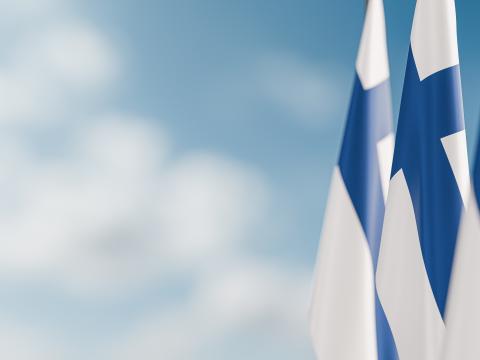Sweden Explores Alternative to Traditional Big Staff Command and Control Unit
Researchers study social dynamics of successful communication in a high-technology, high-stress environment for clues to sound joint battlefield decision making.
Future military command centers may take the form of distributed networks if ongoing research by scientists bears fruit. One new project already has been adapted by the Swedish armed forces and will be partially implemented in its new operational command post.
In the second half of the 20th century, use of technology became the defining characteristic of war. However, in the current discussions of how this revolution is affecting military affairs, Swedish scientists say it is not enough just to examine the most recently developed technologies. Environmental factors and the social dynamic created by the presence of this technology have become equally compelling subjects of study for the military.
The question of what happens in an organization that, either by choice or by necessity, has become completely immersed in these new technologies was the point of departure for a project called ROLF, the Swedish acronym for “Mobile, Joint Command and Control Function” for the year 2010. Begun in 1995 by the Swedish armed forces, the project entails searching for new concepts, work forms and aids for future joint command and control. The research agenda sent scientists in search of answers to questions about the consequences of the presence of technology for personnel, organization and doctrine.
Since 1997, some of the insights from this research have been realized in a laboratory environment called the Aquarium (the AQUA project), which is a testbed for new command and control concepts. However, the ideas demonstrated in this project are not intended solely for military application. Other uses under discussion include commanding peacetime rescues and international operations.
The ROLF concept departs from traditional command and control unit configurations most notably in three ways. First, the staff unit envisioned in the ROLF project is quite small. A second difference is the staff seating arrangement. The third involves the method of displaying information about a crisis situation.
In the initial architecture, a complete staff unit would include at least four staff elements. Each element is to operate as part of a network of centers for excellence rather than as an individual staff cell. Specifically, different nodes—staff elements—in this network will work with different issues concurrently. To create a robust network, a number of small and mobile elements would be fielded, thus avoiding the catastrophic vulnerability of traditional big staff units.
However, the small size presents its own set of challenges. First, the ROLF staff must handle almost the same workload as a traditional-sized staff. The interconnections made possible by modern information technology can bring support and relieve the staff of much of the need for unit coordination. Second, work in the ROLF staff unit is likely to be quite intense, which would require personnel to work in shifts. This opens the door to problems with maintaining continuity of command and control action during several changes in personnel.
The complexity and the dynamics of the command and control situation for a ROLF staff unit are assumed to create high uncertainty. Researchers believe that no human could manage this environment single-handed, so expert knowledge and competence must be instantly accessible. Therefore, in the ROLF concept, extensive resources are accessed through the network.
In addition, to handle a complex situation, a management team is seated close together—in this case around the same table. According to researchers, being seated around the same table has several advantages for people handling complex and dynamic challenges. Successful communication under the stressful conditions of battle is close and physical, researchers note. This is the form of seating that humans have chosen when discussing serious matters, from the gatherings of early Stone Age people around a campfire to meetings convened around conference tables of modern boardrooms. Minimizing psychological distance facilitates serious discussion. The researchers concluded that there must be an opportunity for full communication, including body language and eye contact, to gauge the mental state of the other staff members.
Also, close proximity seating creates a common focus. The staff members can refer in their discussions to a common display of the situation. This facilitates the development of shared situational awareness, and the group’s shared vision of the situation creates robustness in core activities, researchers observe.
In addition to the smaller size and closer configuration of the new command and control unit concept, ROLF deviates from the traditional method of displaying information about a crisis situation. The objective is to illustrate and visualize situations from different perspectives over time in one collective image that is presented to each participant in the staff element or in a number of elements. Traditionally, the military uses a two-dimensional map of the battlefield or crisis area. ROLF project members believe that it is possible to present more informative situation maps by using new technologies and three-dimensional display capabilities as well as multimedia techniques.
ROLF researchers note that despite the associated risk of adding complexity, three-dimensional autostereoscopic display is needed because of the emergence of a new concept of the battlespace. The term battlespace now refers to volume, rather than just a surface. Leaving each staff member to construct mentally that third dimension raises the possibility that different staff members could construct different representations. This in turn could lead to misunderstandings, and there may be little chance to sort out these misunderstandings because of the hectic pace of modern battle. Three-dimensional displays could help avoid such misunderstandings as well as aid less highly trained people such as media representatives and politicians in understanding a crisis situation.
To facilitate dialogue among the participants in the room as well as elsewhere in the network, researchers are studying ways to improve decision makers’ ability to interact with the presentation. The objective is to enable people to manipulate symbols in the representation directly by grabbing and moving them to illustrate a possible course of action in the battlespace.
Henrik Friman is research and project manager at the Swedish National Defense College, Department of Operational Studies, Stockholm, Sweden. The Department of Operational Studies specializes in command and control research of military science.




Comments